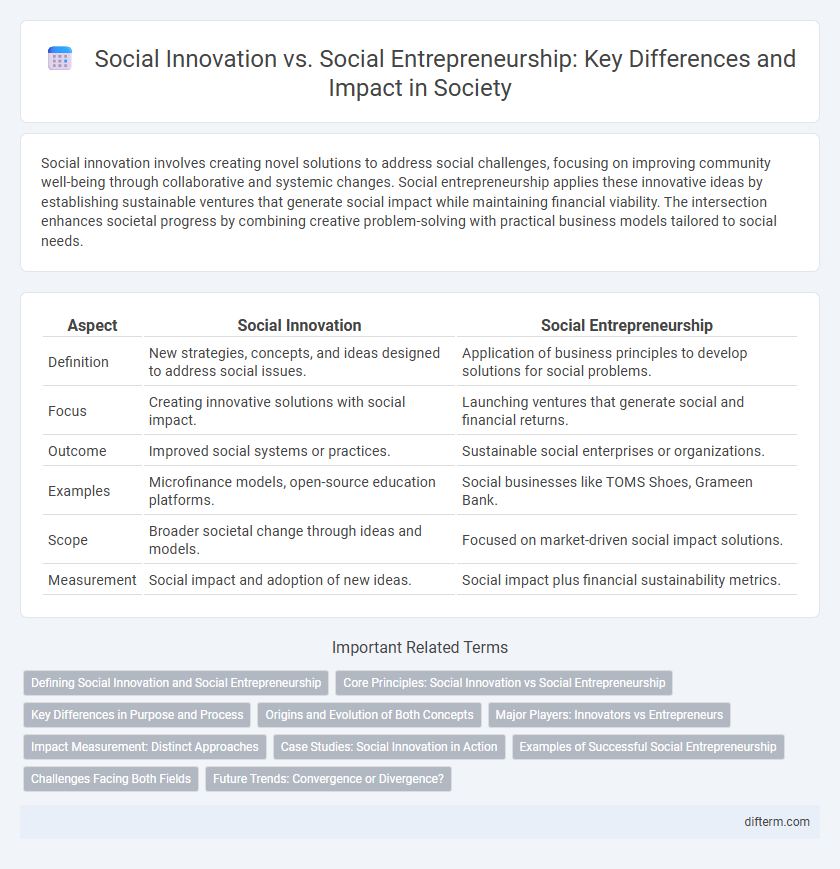Social innovation involves creating novel solutions to address social challenges, focusing on improving community well-being through collaborative and systemic changes. Social entrepreneurship applies these innovative ideas by establishing sustainable ventures that generate social impact while maintaining financial viability. The intersection enhances societal progress by combining creative problem-solving with practical business models tailored to social needs.
Table of Comparison
| Aspect | Social Innovation | Social Entrepreneurship |
|---|---|---|
| Definition | New strategies, concepts, and ideas designed to address social issues. | Application of business principles to develop solutions for social problems. |
| Focus | Creating innovative solutions with social impact. | Launching ventures that generate social and financial returns. |
| Outcome | Improved social systems or practices. | Sustainable social enterprises or organizations. |
| Examples | Microfinance models, open-source education platforms. | Social businesses like TOMS Shoes, Grameen Bank. |
| Scope | Broader societal change through ideas and models. | Focused on market-driven social impact solutions. |
| Measurement | Social impact and adoption of new ideas. | Social impact plus financial sustainability metrics. |
Defining Social Innovation and Social Entrepreneurship
Social innovation refers to novel strategies, concepts, and ideas designed to address social needs and systemic challenges through improved systems and policies. Social entrepreneurship emphasizes the creation and management of ventures that use entrepreneurial principles to solve social problems while generating sustainable impact. Both approaches prioritize social value creation but differ in their methods and organizational focus.
Core Principles: Social Innovation vs Social Entrepreneurship
Social innovation centers on developing novel solutions to address systemic social challenges through creative processes and collaborative efforts, emphasizing inclusivity and sustainable impact. Social entrepreneurship combines innovative problem-solving with business principles, focusing on creating scalable ventures that generate both social value and financial returns. Core principles of social innovation prioritize ideation and systemic change, whereas social entrepreneurship emphasizes implementation, market-driven strategies, and measurable social impact.
Key Differences in Purpose and Process
Social innovation focuses on developing novel solutions to address systemic social challenges through collaborative, iterative processes, aiming for widespread societal impact. Social entrepreneurship centers on creating sustainable, mission-driven ventures that apply business principles to achieve social goals, often emphasizing financial viability alongside social value. The purpose of social innovation prioritizes collective problem-solving and transformation, while social entrepreneurship concentrates on building scalable enterprises with a dual bottom line of profit and social benefit.
Origins and Evolution of Both Concepts
Social innovation originated in the mid-20th century as a response to complex societal challenges, emphasizing novel solutions and systemic change. Social entrepreneurship emerged later, in the 1980s, blending business principles with social missions to create sustainable impact through market-driven approaches. Both concepts evolved through increasing collaboration between non-profits, businesses, and governments, driving scalable and impactful social change.
Major Players: Innovators vs Entrepreneurs
Major players in social innovation are often researchers, policymakers, and non-profit organizations focused on developing novel solutions to social challenges using data-driven approaches and technology. Social entrepreneurs, in contrast, are individual founders or startup leaders who implement scalable business models aimed at achieving sustainable social impact while generating revenue. Both innovators and entrepreneurs collaborate but differ in their roles--innovators emphasize ideation and experimentation, whereas entrepreneurs prioritize execution and market-driven impact.
Impact Measurement: Distinct Approaches
Social innovation prioritizes scalable impact measurement frameworks that assess systemic changes and community-wide benefits, often leveraging qualitative and participatory methods. Social entrepreneurship centers on quantifying direct social return on investment (SROI) through financial metrics combined with social outcomes, emphasizing sustainability and business performance. Both approaches require tailored impact measurement tools but differ in scope, with social innovation targeting broad societal shifts and social entrepreneurship focusing on measurable, enterprise-driven results.
Case Studies: Social Innovation in Action
Case studies of social innovation in action demonstrate transformative solutions addressing systemic social issues through creative collaboration and technology-driven approaches. Unlike social entrepreneurship, which often focuses on market-driven ventures with profit models, social innovation emphasizes scalable impact and cross-sector partnerships to create lasting societal change. Notable examples include the introduction of microfinance programs in Bangladesh and community-driven renewable energy projects, highlighting the practical application and success of social innovation strategies.
Examples of Successful Social Entrepreneurship
Successful social entrepreneurship ventures like Grameen Bank and TOMS Shoes demonstrate powerful models for addressing social issues through innovative business solutions. Grameen Bank revolutionized microfinance by providing small loans to impoverished families, empowering economic development and social upliftment. TOMS Shoes popularized the one-for-one giving model, donating a pair of shoes for every pair purchased, effectively combining consumerism with social impact.
Challenges Facing Both Fields
Social innovation and social entrepreneurship both confront significant challenges such as securing sustainable funding, navigating complex regulatory environments, and achieving measurable social impact. Limited access to resources and partnerships often hinders scalability and long-term viability in these fields. Furthermore, balancing social goals with financial sustainability remains a persistent obstacle for practitioners and organizations alike.
Future Trends: Convergence or Divergence?
Social innovation and social entrepreneurship are increasingly intersecting as future trends highlight a convergence driven by technology integration, collaborative platforms, and impact measurement tools. Emerging models emphasize scalable solutions that blend innovative practices with entrepreneurial strategies to address complex social challenges more effectively. However, some sectors still witness divergence, with social innovation focusing on systemic change and social entrepreneurship prioritizing sustainable business models.
social innovation vs social entrepreneurship Infographic

 difterm.com
difterm.com